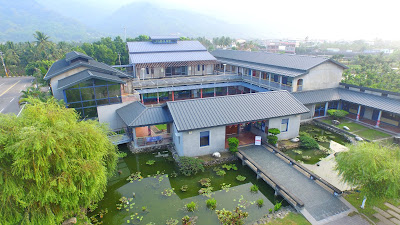Meinong Hakka Cultural Museum - Must-visit in Meinong, Kaohsiung
Hakka, the second biggest ethnic group in Taiwan, comprising of about 20% population that second to Hokkien (or Hoklo), is identified with the distinctive language, culture, architecture and so on.
The main areas Hakka people locate are the north and the south of Taiwan, and there is similar (not total the same) culture in each place. With over 90% population of Hakka people, Meinong not only is one of the representatives of Hakka communities in Taiwan but also owns its particular Hakka custom that differs from others so that I will define as Meinong Hakka.
Nowadays, the boundary of Hakka and others has been blurry, and it hardly recognises who Hakka are by what they wear or what they speak in person. However, in Meinong, Hakka is the daily life of the residents from the conversation on the streets, the food on people's table, to the religious ceremonies.
The unique culture has become one of the reasons of tourists visiting Meinong and Meinong Hakka Cultural Museum that is Hakka-oriented inside out provides a systematic and vivid introduction of Meinong Hakka. Its architecture is built based on the Hakka traditional San-he Yuan(三合院夥房) and tobacco building; in addition to Hakka culture, it is dedicated to the history, economy, and representative landmarks of Meinong which are shown in its permanent exhibition.
 |
| The central building of the museum |
The permanent exhibition is placed in the central main building. On the wall of both sides of the entrance are there two large paintings by a local artist Zeng Wenjhong(曾文忠), portraying people's lives in the past Meinong. Based on River Meinong, the right one illustrates how the ancient people relied on and related to the river. Women washed the clothes standing in the river while a wedding was being held at the Sanheyuan nearby the river. The left picture describes a traditional "Writing Paper Ceremony" taken place on the birthday of the Jade Emperor(玉皇大帝、天公) every year.
 |
| The painting describes the past daily life |
Revealing the terrain of Meinong, this ceramic relief also implies the significance of ceramic art in Meinong. The most famous one is Mei Nung Yao (美濃窯), the art of Chu, Pan-Hsiung(朱邦雄), which locates under Mountain Ling (靈山).
The museum displays the miniatures of the representative landmarks and architectures in Meinong such as Oblation Furnace, East Gate Tower, and the central hall of the Sanheyuan.
 |
| Oblation Furnace |
 |
| East Gate Tower |
 |
| The ancestral shrine of the Sanheyuan |
As a rural village, Meinong relies on water resource a lot. This space states the contribution of Chutsumen Water Power Plant(竹子門發電廠) whose water used for generating hydropower providing irrigation for Meinong farmland, enabling harvests from once a year to twice.
 |
| The irrigation channel flowing through the plain |
This room simulates the environment of the Yellow Butterfly Valley in not only visual but also audio ways. Here simulated butterfly image can be observed and the chatter of the birds in the valley can be heard.
The exhibition space on the second floor mainly features two topics: the tobacco industry and Hakka music. Tobacco planting has played a significant role in the history of Meinong economic development. Since Japanese ruled era, Meinong started an extensive range tobacco planting in winter lasting for over 60 years, and the generous income due to the guarantee price policy has fed numerous families. From 2017, tobacco field may become history because there is no longer guarantee price for tobacco under the principle of the WTO that Taiwan has joined as a member.
This area showcases the process of how tobacco leaves become cigarette, and a mimic model of tobacco shed and the scenario of how people work inside are displayed. The function of tobacco sheds is to cure the leaves via the heat of the building.
Three relics rooms are refurbished and re-curated in 2016 showcasing the ancient tools for traditional agriculture, daily life, and food separately. However, it is a pity there is no English introduction in these rooms.
 |
| How ancient farmer did in the farm |
 |
| The altar along with the both stands for sacrifice offerings (pig and goat) hanging |
One of the missions of the museum is to preserve Hakka culture in many ways. The exhibitions statically display the culture while recently the museum has curated a series of live shows to enable "culture", the look-alike serious concept, much closer and more internalised to visitors' hearts. The live shows in 2017 include "The Master of Meinong Traditional Crafts" that invites the local handicraft artists to perform their skills. The first topic is the rattan chair.
Meinong Hakka Cultural Museum that presents the miniature of Meinong life and society is a must-see museum for people visiting Meinong for the first time and willing to have a basic knowledge about the Hakka rural town.
Meinong Hakka Cultural Museum that presents the miniature of Meinong life and society is a must-see museum for people visiting Meinong for the first time and willing to have a basic knowledge about the Hakka rural town.
Meinong Hakka Cultural Museum
Address: No. 49-3, Minzu Road, Meinong District, Kaohsiung City, 843 (Map)
Opening time: 9AM to 5PM every Tuesday to Sunday
Ticket: NTD40/ adult
Address: No. 49-3, Minzu Road, Meinong District, Kaohsiung City, 843 (Map)
Opening time: 9AM to 5PM every Tuesday to Sunday
Ticket: NTD40/ adult





Meinong Hakka Social Exhibition hall that presents the smaller than normal of Meinong life and society is a priority historical center for individuals visiting Meinong interestingly and ready to have a fundamental information about the Hakka provincial town: waiting-chair
ReplyDelete